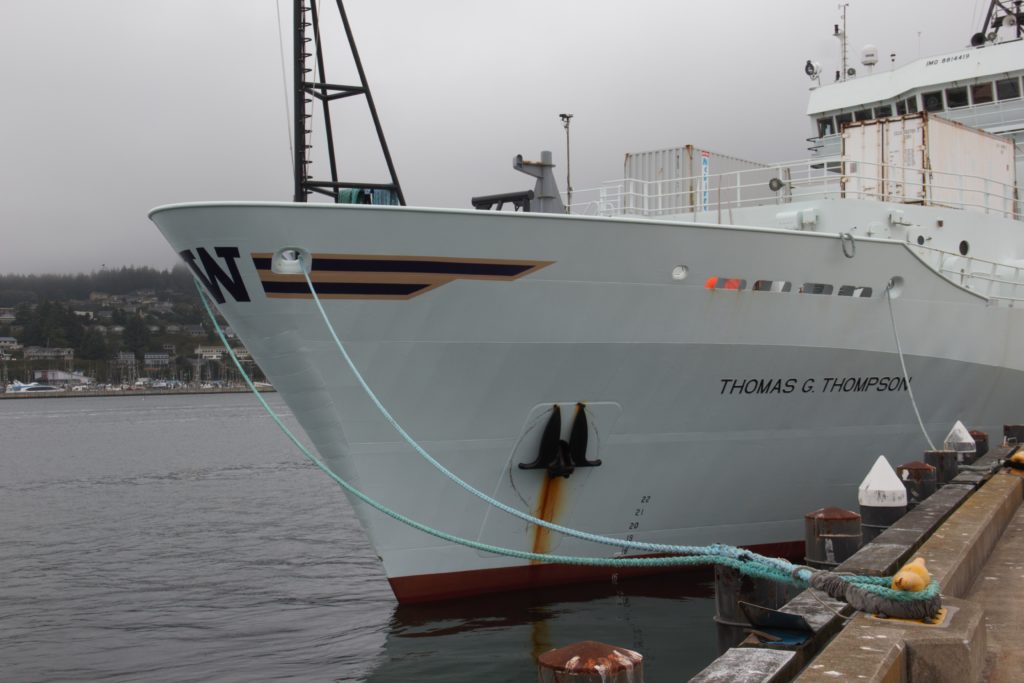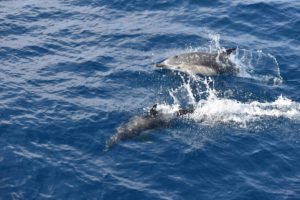
6 September 2023
Over the last few days, I’ve spent a lot of time helping out in the ROV control van. We ended up visiting several hydrothermal vents in Axial Caldera, and it was cool to see the rock formations and different kinds of life that can be found at that depth. I’m glad we were able to have a few more successful dives after the Jason was out for a few days due to weather and maintenance issues.
Operations for this Leg ended yesterday, and now we’re heading back to Newport. While in transit last night, we were lucky enough to see some bioluminescence off the stern. It was also a really clear night, so we were able to go stargazing. All the students went up to the top deck and laid down, and we listened to music and just enjoyed the moment. I was hoping to experience something like this the whole trip, so I feel fortunate that it worked out the last night we were on the water.

It feels like this moment marked the end of a special experience, and I’ve taken some time to reflect on this. It’s been amazing to be a part of such a unique field of research, and I’ve been able to learn so much in just two weeks. Having the opportunity to help in the ROV control van was a really interesting experience, and one that I took a lot away from. Living on a ship this size was also a new experience, but it was so nice to be able to bond with the other students and fall into the rhythm of life at sea. I have many happy memories from this trip, and I can’t wait to continue the work we started here in the fall.

4 September 2023
The last few days have gone by quickly, as we’ve gotten back into the flow of life on the ship. The first shift of the Leg was on site at Axial Seamount, and we helped to collect samples from a CTD that had been deployed.
This was my first time working a shift late at night, and it was a nice change. Unfortunately, it was still cloudy, so I haven’t been able to see any stars yet. I’m hoping we’ll get lucky during our last few days on the ship.
The ROV was also finally able to get back in the water yesterday, and it was nice to see that operations on the ship had picked up again after the poor weather put us on hold for a few days. While assisting in the control van, we happened to see a swordfish checking out the Jason. This was a really memorable experience, and I feel fortunate that I have been able to see so much diverse wildlife on this trip.
Everyone has also been hard at work getting our project presentations ready, as we’ll be presenting what we have so far on our way back to port. Because of this, I’ve been working to get as much footage as I can of operations on the ship while we are still onboard.
It feels like Leg 3 has gone by so much quicker than Leg 2, and I can’t believe that tomorrow we will start the transit back to Newport. This trip has been an amazing learning experience, and I can’t wait to continue this work in the fall.

2 September 2023
The Thompson has spent the last few days in port, preparing for Leg 3. This meant that the students were released from our normal duties, and so to pass time, we’ve spent a lot of time exploring the area around Newport.
After our arrival on Tuesday, the first thing we did was visit the Oregon Coast Aquarium. The aquarium had many interesting exhibits, such as shark tunnels and an area dedicated to seabirds. It was cool to see some of the animals that were spotted on dives up close, such as the Giant Pacific Octopus.
The next day, we decided to make the long trek into Newport. After crossing the Yaquina Bay Bridge, we spent some time on the bayfront. On the docks, sea lions piled on top of one another, and we could hear their barks from across the bay. We also explored one of the nearby beaches. This was a nice break from the structured life on board the ship, and it was fun to spend some time with the other students.
On the Thompson, preparations for Leg 3 included loading up new gear, as well as stocking up on more food and supplies. The students tried to help with this when we were around, and it was interesting to see what some of the preparations entailed.
We’re underway again now, heading back towards Axial Seamount. The weather on this Leg has been much rougher so far, and it’s been a hard adjustment. I’ve spent a lot of the last day sleeping or hanging out on the deck, trying to avoid becoming seasick. Despite this, I’m really excited for our arrival, as it will be nice to be able to continue the work we were doing on the last leg.

28 August 2023
Over the last few days the Jason has conducted many dives, resulting in some amazing experiences. During my watch yesterday, we saw a shark during the descent, and on a different watch, multiple sunfish approached the rear cameras and posed for several minutes. Earlier today, we happened to see a small Giant Pacific Octopus during a survey on a junction box. We were able to get a few minutes of high-quality footage, watching as it explored the artificial structure. Seeing wildlife in this context is a really special experience, and always makes me look forward to my next shift.
On deck, we’ve continued to clean sensors as Jason retrieves them. It’s always exciting to see what will come up with the instruments, as we’ve occasionally seen crabs and other small animals.
Working on deck and observing the crew is a unique learning experience, and it’s been interesting to see the different kinds of work that can be done on a research vessel.
In the last few days, I’ve learned that it’s important to balance work and sleep. Although it’s tempting to stay up for extended periods of time to not miss out on the action, it’s important to get rest to ensure I will be alert during my watches.
I’ve also spent some time relaxing with the other students. We try to watch the sunsets when we can, as they usually look gorgeous from the water. Last night we got up early in the morning to try and go stargazing, but unfortunately some clouds had moved in. I’m hoping we’ll have better luck when we head back out to Axial Seamount next week. This trip has been an incredible experience so far, and I’m looking forward to being back in port for a few days before we head out for Leg 3.

26 August 2023
After we arrived on site at Axial Seamount early yesterday morning, the amount of work students and scientists were tasked with increased drastically. I had my first watch of the Leg, and during this shift, we were assisting in the ROV control van. In the van, students are responsible for maintaining a log of each dive, as well as taking 4K video and still photographs throughout the dive at the direction of the scientists and engineers on watch.
Listening to the operations as Jason went over the side for the first time felt kind of like watching a rocket launch- there were countless checks and communications taking place to ensure that the dive would be successful. This shift was an interesting learning experience, and really helped me see what goes into operating Jason.

During the remainder of the evening, all of the students spent some time working on our project proposals. For the rest of the trip, we will be working to collect data and footage to create a media presentation. My project will be a video of the work students do, focusing on both the research we’re conducting and what day to day life looks like on the ship.
The work didn’t stop there, as today we were tasked with cleaning a variety of instruments that had been retrieved on dives. Using a pressure washer and scrubs, we worked to remove the buildup of algae and other marine goo that had concentrated on the instruments. It’s important work, but perhaps not the most inspiring.

25 August 2023
Leg 2 got underway yesterday, and after a long day in transit (22 hrs), we are finally on site at Axial Base! The time I’ve spent on the ship so far has been a great learning experience. Our Leg started in Newport, OR as the Thompson spent the night docked waiting for the expedition to begin. During this time, we had a safety meeting, where we went over the various alarms and emergency protocol, and learned how to properly don immersion suits.
That evening, we explored the ship and spent some time in the lounge relaxing. During transit there was a lot of downtime, so I tried to pass the time reading and occasionally napping. Our daily meeting was a presentation about research on deep sea organisms, which was a fun way to learn more about what we’ll be seeing on this trip.
In preparation for when we arrived on site, all of the students learned how to properly rig the Niskin bottles on the CTD. This allows us to collect water samples from various depths.

We arrived on site early in the morning, and around 0430 today the CTD was deployed for the first time. The samples from this CTD will provide information on chlorophyll, nutrient levels, and other important data.
Unfortunately I missed out on the early-morning action, as I’m still working to get my sleep schedule adjusted to life at sea. However, after breakfast we were treated to a sighting of dolphins! Everyone in the lab rushed onto the deck and watched as a large pod of dolphins swam just past the boat. For 10 or 15 minutes the dolphins were in view, and we watched as they made repeat passes around the stern. In the distance, we could see more dolphins jumping, sometimes visible only by the trail they left in the water. This was a really special moment, and hopefully marked the start of a successful leg on the Thompson.
